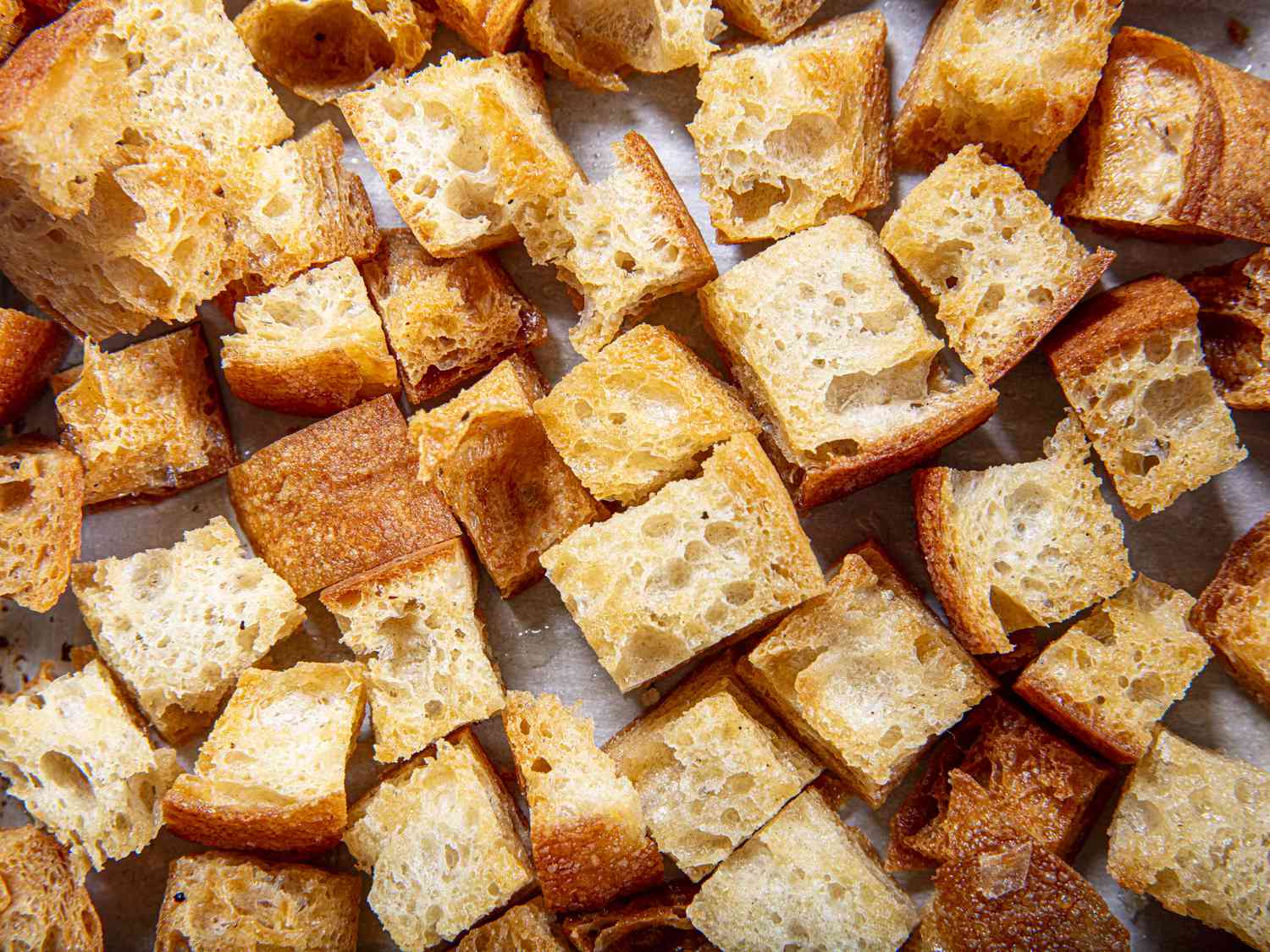
Why It Works
- Using crusty bread like ciabatta, baguette, or sourdough produces extra crisp croutons with satisfying crunch.
- Stirring the croutons occasionally as they toast in the oven results in evenly golden-brown pieces.
Many people dread their loaves of bread going stale, but I look forward to it. Rather than dwell on all the toast I could have had, I see it as a window of opportunity to give my bread new life, usually in the form of croutons. Croutons are key to many of my favorite meals, bringing crunch and flavor to my soups and salads.
Serious Eats / Amanda Suarez
Though it’s easy to go the store-bought route, homemade croutons are typically more delicious than store-bought ones, and an economical way to repurpose a loaf that’s too stale to enjoy without a little help. With the recipe I’m sharing here, you can make homemade croutons in about 30 minutes and they keep for up to a week—so you’ll extend the life of that stale loaf and have delicious salad and soup toppers for days.
According to Alan Davidson’s Oxford Companion to Food, the word “crouton” is derived from the French word “croûte,” which means “crust.” He notes that the term dates back to the 17th century, when it referred to a small piece of bread served with drinks. Croutons also appear under a different name in the 1877 book Cassell’s Household Guide, which contains a recipe for “a la viennet” (bread fried for soup). The recipe instructs cooks to slice bread into half inch–thick pieces, remove the crust, then shape the bread into “the size of a two-shilling piece” for frying in a pan with butter until browned. The method isn’t dissimilar to how many people prepare croutons today. Given how much people still enjoy croutons these days, it’s safe to say that our love for crisp morsels of bread is evergreen.
To figure out how to make the best croutons, I made batches and batches of them, testing different breads, cooking temperatures, and fats. Here are my tips and tricks for making the crunchiest croutons for topping various dishes or eating right out of the pan.
6 Tips for Better Croutons
Use a crusty loaf. For the croutons with craggy edges that become ultra-crisp, I recommend a rustic sourdough loaf, baguette, or ciabatta. The large air pockets in these loaves means there are plenty of nooks and crannies—this extra surface area helps the croutons become very crispy when baked.
Don’t forget to stir. While I call for cooking the croutons in the oven on a baking sheet, you can’t just chuck them in the oven and forget about them. For croutons that are evenly browned, use a spatula or wooden spoon to stir them occasionally, about every five minutes. The croutons arranged around the perimeter of the baking sheet will absorb the brunt of the oven heat, and stirring them prevents some of the croutons from getting darker than the others.
Serious Eats / Amanda Suarez
Bake at 350ºF or 175ºC. For golden-brown croutons, we want to kickstart the Maillard reaction, a series of chemical reactions that occurs when heat transforms protein and sugar molecules, resulting in more complex flavors and aromas. The croutons should brown—not burn—and 350ºF is the Goldilocks temperature for that. Any higher than that, and you may find yourself with little lumps of charcoal. Any lower than that, and you’ll be waiting for an unnecessarily long for the bread to toast.
Skip the butter. In my testing, I found that croutons tossed in melted butter were crunchy, but they weren’t as shatteringly crisp as those tossed in pure fat like olive oil, lard, schmaltz, or bacon fat, since the milk solids and water in butter can cause uneven browning. You can certainly make your croutons with butter if you prefer its sweet, creamy flavor, but you may have to toast your bread for slightly longer—and accept that they simply won’t be as brittle as croutons coated in oil.
Serious Eats / Amanda Suarez
Avoid ceramic and stoneware when baking. These materials are poor conductors of heat, making it more difficult for croutons to crisp. I recommend using an aluminum rimmed baking sheet, which conducts heat well and has enough surface area for the croutons to brown. Its rim will also allow you to stir without fear of knocking croutons onto the hot oven floor.
Season your croutons generously. The only thing worse than a soggy crouton is a bland one. Salt and black pepper go a long way, and highlight the savoriness of the bread. If you’re using sourdough, salt helps to bring out its tangy, fermented flavors and results in a more complex tasting crouton.

